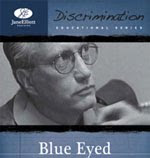Week 9: Blue Eyed
 Blue eyes. Poets write about them; The Who, Elton John, and British popster Mika sing about them; Frank Sinatra personified them. But what if blue eyes were an undesirable trait, one that inspired discrimination? That’s the premise of Jane Elliot's film “Blue Eyed.” The film is the fourth and final selection in this year’s (tenth annual) Eracism Film and Discussion Series. The series “is designed to heighten awareness and create a better understanding of the issues facing people of color or of minority ethnic backgrounds.”
Blue eyes. Poets write about them; The Who, Elton John, and British popster Mika sing about them; Frank Sinatra personified them. But what if blue eyes were an undesirable trait, one that inspired discrimination? That’s the premise of Jane Elliot's film “Blue Eyed.” The film is the fourth and final selection in this year’s (tenth annual) Eracism Film and Discussion Series. The series “is designed to heighten awareness and create a better understanding of the issues facing people of color or of minority ethnic backgrounds.”In the aftermath of the assassination of Dr. Martin Luther King, Jr., then-third-grade-teacher Jane Elliott wanted a way to get her students thinking about the damaging effects of discrimination. She divided her class into two groups: blue-eyed and brown-eyed. The blue-eyed students then spent the day treating the brown-eyed students as lesser individuals. The nature of the lesson proved very effective but did not endear Ms. Elliott to her fellow townspeople. Her family suffered serious hardship as a result.
 Later in her career as diversity trainer, Ms. Elliott repeated the exercise with adults. This time, the blue-eyed among the group were discriminated against. “Blue Eyed” is the documentary film of this experience. Ms. Elliott is no cuddly grandma-type, and it was fascinating and distressing to watch the blue-eyed adults—who knew they were part of a brief social experiment—falter under her treatment. And it was humbling to hear other participants describe the ways in which they experience discrimination based solely on their skin color.
Later in her career as diversity trainer, Ms. Elliott repeated the exercise with adults. This time, the blue-eyed among the group were discriminated against. “Blue Eyed” is the documentary film of this experience. Ms. Elliott is no cuddly grandma-type, and it was fascinating and distressing to watch the blue-eyed adults—who knew they were part of a brief social experiment—falter under her treatment. And it was humbling to hear other participants describe the ways in which they experience discrimination based solely on their skin color.I grew up as a white girl in a predominantly white community. I doubt I’ve ever been discriminated against in any meaningful way based on my appearance. I also happen to have blue eyes. My sister and I share a strong resemblance, but she has brown eyes. As I watched the film, I couldn’t help but think that my sister and I would have been on opposite sides of Ms. Elliott’s room—despite possessing the same genetic material handed down from the same parents. That’s how senseless discrimination is.
After the film, Dr. Patricia Vigil, Assistant Professor of Sociology at CSU, led a discussion of the film. (For more information about diversity at CSU, click here.) I should ‘fess up here and admit that I’m sometimes tempted to sneak out the back when ‘discussion time’ rolls around. But I’m glad I stayed. One of the attendees shared what it was like to grow up in a Klan family. Another told of his experience as a participant in a Jane Elliott experiment. Others gave examples of how discrimination affects them, and their families, right here in our city.
I like to think Fort Collins is an inclusive community, but we’re not perfect. We can all stand to learn more about the issues facing our—and this country’s—increasingly diverse population. The Eracism film series is an excellent place to start. “Blue Eyed” is showing again tonight (Oct. 13) at 6:30 at the Harmony Library.

Comments